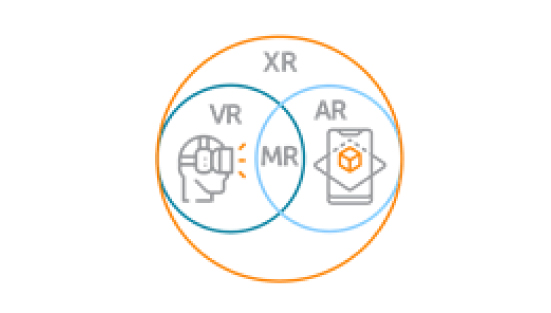WebXR - New horizons of VR and AR on the web
In today's cutting-edge technological scenario having challenging environment, companies are looking for cost effective alternative solutions in every business vertical. Now the customer does not want any additional software/app to be downloaded on device, rather solutions should be available on the fly. This situation makes WebXR an effective and efficient tool to cater to a large segment of the customer base.
What is WebXR
WebXR is an API for web content and apps to interface with mixed reality hardware. This includes both managing the process of rendering the views needed to simulate the 3D experience and the ability to sense the movement of the headset (or other motion-sensing gear) and provide the needed data to update the imagery shown to the user.
WebXR additionally provides support for accepting inputs from control devices such as handheld VR controllers or specialized mixed reality gamepads.

What is AR and VR
Augmented Reality (AR) is the innovation that combines the genuine/real world and the imaginary/virtual world. AR Gadgets upgrade our discernment of reality through the joining of computer created data and imageries into our faculties. These contraptions overlay data and rendered pictures onto physical objects and real-life circumstances. AR isn't confined to specific innovations (e.g. Head Mounted Devices) and possibly isn’t restricted to the sense of location.
Virtual Reality (VR) on the other hand could be a computer recreated, man-made environment that can take motivation from the physical highlights of the genuine world. Incidentally VR Gadgets are able to trick our faculties into accepting that the recreated world is real. This immersive medium has the control to form novel encounters that are unattainable anyplace else. VR can be considered man-made, multi-sensory, intuitive and immersive.
In VR world, clients totally immerse themselves into the artificially created environment, on the other hand AR clients are closer to the real world but have collaboration with virtual objects created to augment the scene. AR works better for confined, specialized themes. On the other hand, VR is way better for complex, soft-skill content.
App based virtual or augmented reality is expensive in terms of resources, programming/software, hardware, etc, whereas the use of the web-based systems give tremendous advancement to both consumers and producers.
First and foremost reason is that a web based system does not require a new stack of hardware/software to enhance the system to bring in a new experience for the customers.

It is important to say that the app-based system takes more time to operate upon, has more storage requirements and platform dependencies. This makes web-based technology more accessible, adoptable and beneficial.
At Mozilla in 2014, Vladimir Vukićević first introduced the WebVR API. Subsequently in 2016, Mozilla VR team and Google Chrome released v1.0.
In 2018 WebVR was superseded by webXR Device API, keeping in view of the AR, VR and other possible futuristic devices.
In 2022, a working draft of WebXR Device API was published by Google and Meta, along with members from Microsoft, Mozilla, Apple, Samsung Electronics, etc.
WebXR Device API is a Web application programming interface that describes support for accessing augmented reality and virtual reality devices, such as the HTC Vive, Oculus Rift, Oculus Quest, Google Cardboard, HoloLens, Magic Leap or Open Source Virtual Reality, in a web browser.
The "Basic Certificate course in Augmented and Virtual Reality" course is available at FS Prime website, which provides the basic building block for the WebXR and other upcoming technologies. After completing this course participants can target job roles such as VR/AR developer, XR Architect, Solution Developer, etc.
Source: https://developer.mozilla.org/en-US/docs/Web/API/WebXR_Device_API/Fundamentals
Written by NIELIT Chandigarh


